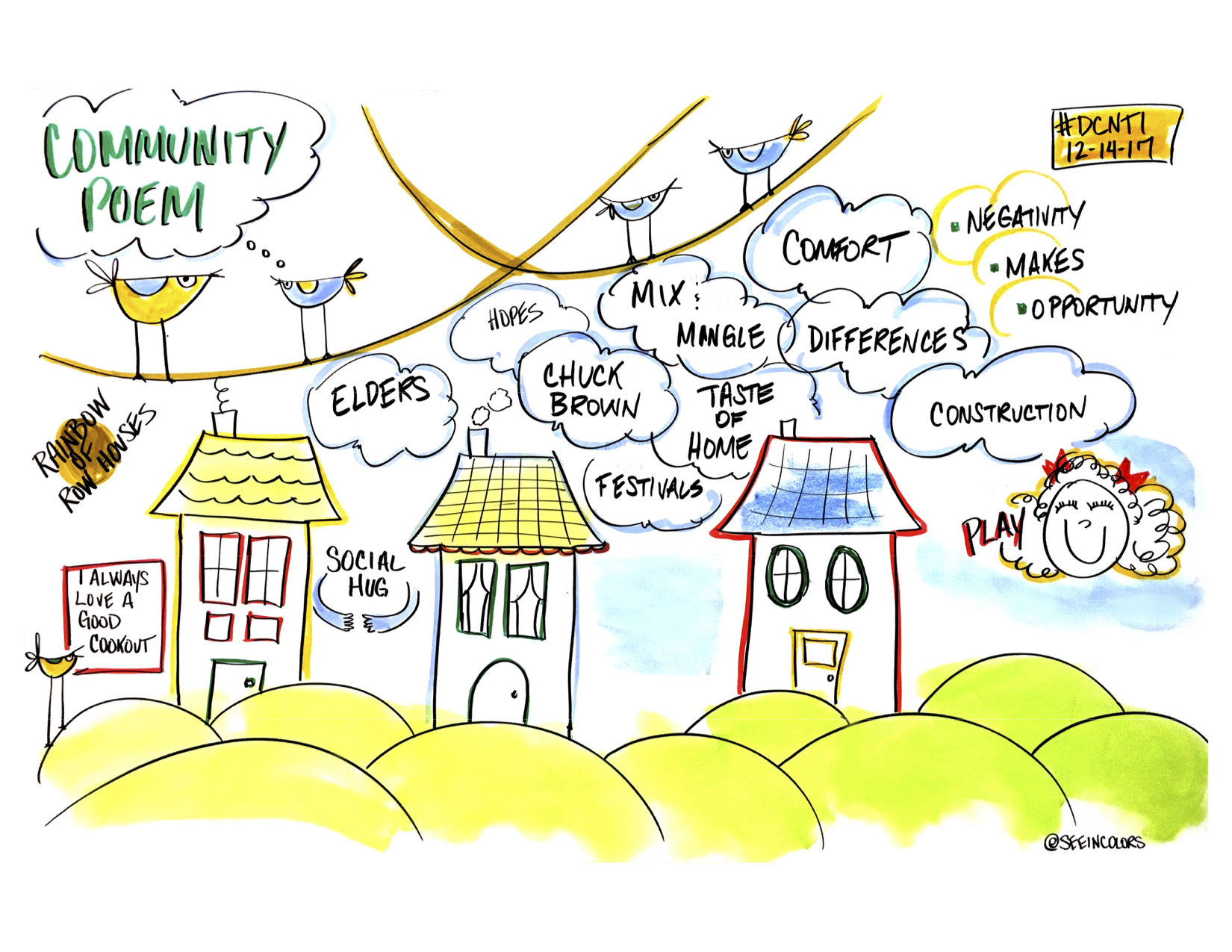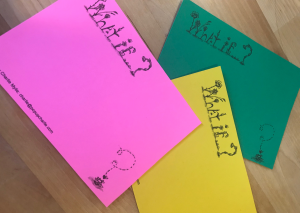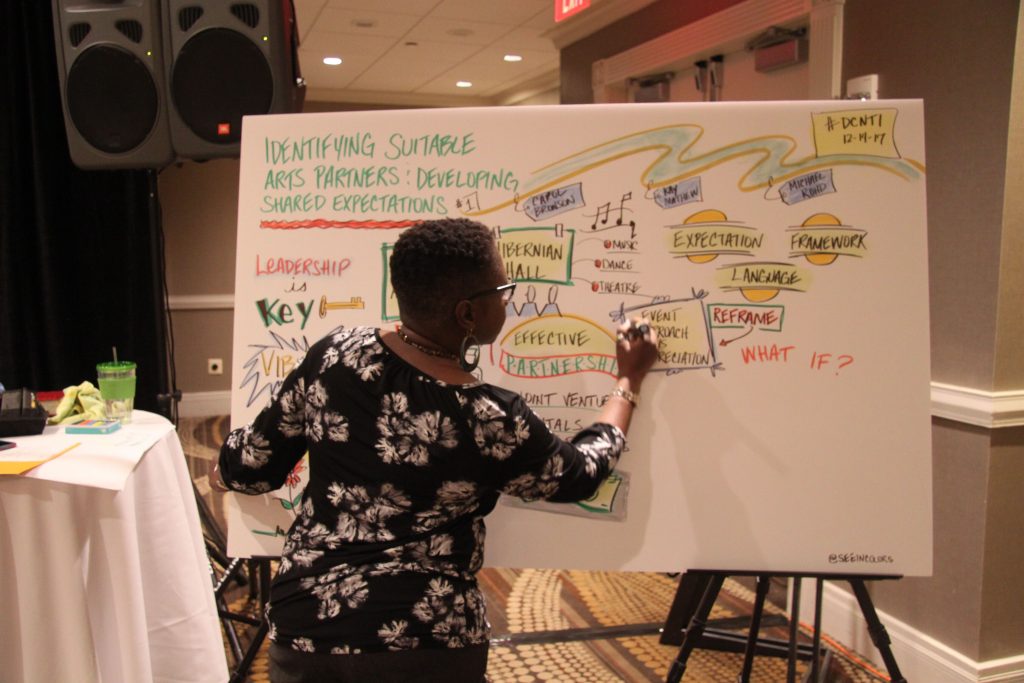
Illustration of the community poem from Lisa Nelson, of See In Colors.
Community is a block party where everyone is invited. Bring your best dance moves, your favorite food.
This is the first line of the “community poem” that artists Holly Bass and Maryam Fatima Foye performed to close a convening in a nondescript conference hotel ballroom in December, 2017. It’s called a community poem because Holly and Maryam didn’t write it themselves. Each person at the convening contributed one line. They were told to think of their ideal or current community and respond to one of the following prompts: “My community looks like…,” “My community tastes like…,” “My community smells like,” “My community sounds like…” Then Holly and Maryam assembled the lines together in a poem. People in the room began to expect the refrain:
This is what our community feels like
Looks like
Tastes like
Smells like
Sounds like
Holly didn’t just arrive at the ballroom to perform a poem. She was an integral part of the Metris team that planned and facilitated a day-long convening with recent Metris client, NeighborWorks America. For over a year, Metris supported NeighborWorks in a planning process to surface how its national network of nearly 250 affordable housing and community development organizations currently use arts and culture to achieve their community development objectives. With this information, we then identified ways NeighborWorks can best provide support for this work within their network and beyond. We’re thrilled that NeighborWorks recently released the culmination of this work: Creative Community Development: Final Report.
But we’re not writing this blog post to celebrate the final report’s release. In this post, we reflect on how we worked with three artists to bring innovation, creativity, and fun to the NeighborWorks planning process. Through our collaborations, the artists also modeled ways community developers can partner with artists to deepen and enhance community engagement. Let’s rewind… before we even got to the community poem, we worked with two other artists earlier in the project that informed our collaboration with Holly.
We kicked off the project in Minneapolis at NeighborWorks’ huge National Training Institute. Twin Cities-based artist, Mankwe Ndosi, supported NeighborWorks during a day-long meeting of over 100 people. In one of our small group exercises, we introduced ourselves with the prompt, “I come from people who…” (For example, the introduction I gave included, “I come from people who left Ireland during the potato famine; from people who pursued careers in rural Nebraska; from people who are teachers.”) This exercise invited us to be vulnerable and show our complexities as people who carry our ancestors with us. It made power dynamics explicit, for instance that some participants’ ancestors were enslaved and others owned slaves. Another way Mankwe contributed to the meeting was humming and singing to get our attention, as we transition from small group activities back to the large group.
Metris came on board after NeighborWorks had planned much of the meeting. From Mankwe, we learned about the value of engaging artists at the beginning of planning an event. This way, they can act as thought partners and bring so much more than “icing on the cake,” (such as an engaging and inspirational opening or closing performance), as Mankwe put it.
Next, we planned a mid-project retreat in Kansas City, MO for the nearly 20-person project steering committee. We took Mankwe’s advice and put out a call for a local “artist/facilitator” at the very beginning of retreat planning. We envisioned that the artist—visual or performing—would integrate creative practice throughout the meeting. The overall objective was to raise the bar, in terms of thinking, among retreat participants and have fun. We decided to work with Julia Cole. As we planned the retreat together, Metris knew what we needed to get out of the retreat and Julia helped us think through how we’d get there.
 A highlight of working together was using “What If…?” cards designed by Charlie Mylie, a local illustrator that Julia knew. During small group share-outs, people responded to what they heard from their peers by jotting down questions, “ah ha” moments, and reflections on colorful cards with the prompt “What If…?” Then, we invited folks to deliver their cards to the groups and engage in a conversation about what they had written on their cards. This exercise encouraged people to listen carefully and let their mind wander through possibilities, no matter how big or small. It also helped the people who received the cards explore new avenues that they might not have thought of, otherwise.
A highlight of working together was using “What If…?” cards designed by Charlie Mylie, a local illustrator that Julia knew. During small group share-outs, people responded to what they heard from their peers by jotting down questions, “ah ha” moments, and reflections on colorful cards with the prompt “What If…?” Then, we invited folks to deliver their cards to the groups and engage in a conversation about what they had written on their cards. This exercise encouraged people to listen carefully and let their mind wander through possibilities, no matter how big or small. It also helped the people who received the cards explore new avenues that they might not have thought of, otherwise.
And then that brings us back to Holly. She provided invaluable insights as we planned the final convening with more than 70 community developers, local government staff, artists, and creative placemaking funders and researchers. Holly also presented three brief arts performances during the event. The biggest hit? When Holly, Maryam, and Kokayi Issa took convening participants’ ideas related to community development and freestyled short Hip hop pieces. We also worked with graphic recorder, Lisa Nelson of See in Colors, to graphically document the day-long meeting.

Lisa Nelson of See In Colors graphically recording the day-long meeting. Photo by David Plihal.
NeighborWorks continues to work with artists, as described in their recent blog post, “Artists and community-development nonprofits: how to make the match work.” And in multiple project proposals we’ve submitted since working with Mankwe, Julie, and Holly, we’ve budgeted money to collaborate with an artist who can help us plan and facilitate parts of the project. We’re excited to continue learning how to work with artists and see how their contributions make our work better.
What We Learned:
- Engage artists early
- Collaborate with artists on the process, not just the outcome
- Artists can bring fresh perspectives. Suspend ideas of what a meeting should look like and practice flexibility and openness to new ways of doing things.
- The value of local. The artists we worked with had solid grasps on the local arts and cultural context, which was helpful for this project. We supported the local creative economy. And, meeting participants who lived where we convened now know about a local artist they can work with in the future!
- Different artists bring different skills and perspectives to collaborations
- We’ve emphasized this in previous reports, but with this project, we had the opportunity put the value, “artist should be fairly compensated” into practice
- When in doubt, end a meeting—or a blog post—with a community poem
Community feels like, looks like, sounds like a social hug, a spontaneous dance party, laughter on a quiet afternoon.
We are all humans that experience the joys and hardships of life. Community allows us to not be alone in all of it.Â
This is what our community feels like
Looks like
Tastes like
Smells like
Sounds like
